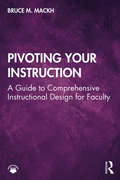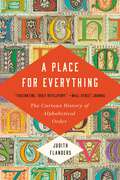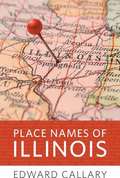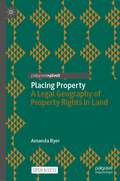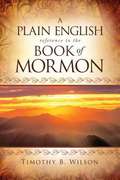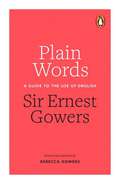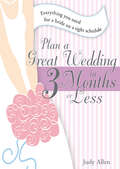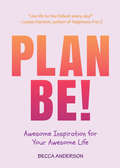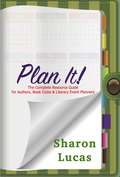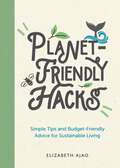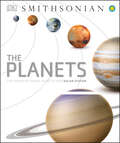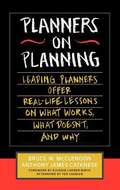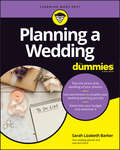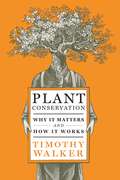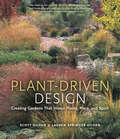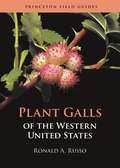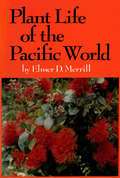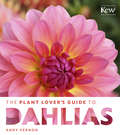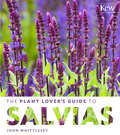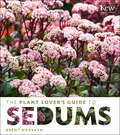- Table View
- List View
Pivoting Your Instruction: A Guide to Comprehensive Instructional Design for Faculty
by Bruce M. MackhThis practical guide for college and university instructors explains how to design and prepare your courses to be adaptable for a full range of learning environments—whether that’s online, hybrid, or face-to-face traditional campus teaching. Author Bruce M. Mackh unpacks a comprehensive instructional design approach to curriculum and instruction that is suitable for all modalities and allows you to pivot quickly, regardless of how the course will be delivered. Chapters provide quick takeaways and cover challenges and opportunities, adapting high-impact practices across instructional models and fostering a culture of care. The book also encourages faculty members to adopt a student-centered mindset as they employ the principles of Design Thinking, User Experience Design, Instructional Design, and Learning Experience Design to create a high-quality course. The strategies at the heart of this book will help both new and experienced faculty save time, ensure instructional continuity during transitions, and achieve excellence in teaching.
A Place for Everything: The Curious History of Alphabetical Order
by Judith FlandersFrom a New York Times-bestselling historian comes the story of how the alphabet ordered our world.A Place for Everything is the first-ever history of alphabetization, from the Library of Alexandria to Wikipedia. The story of alphabetical order has been shaped by some of history's most compelling characters, such as industrious and enthusiastic early adopter Samuel Pepys and dedicated alphabet champion Denis Diderot. But though even George Washington was a proponent, many others stuck to older forms of classification -- Yale listed its students by their family's social status until 1886. And yet, while the order of the alphabet now rules -- libraries, phone books, reference books, even the order of entry for the teams at the Olympic Games -- it has remained curiously invisible.With abundant inquisitiveness and wry humor, historian Judith Flanders traces the triumph of alphabetical order and offers a compendium of Western knowledge, from A to Z.
Place Names of Illinois
by Edward CallaryThis extensive guide shows how the history and culture of Illinois are embedded in the names of its towns, cities, and other geographical features. Edward Callary unearths the origins of names of nearly three thousand Illinois communities and the circumstances surrounding their naming and renaming. Organized alphabetically, the entries are concise, engaging, and full of fascinating detail revealing the rich ethnic history of the state, the impact of industrialization and the coming of the railroads, and insight into local politics and personalities. Many entries also provide information on local pronunciation, the name's etymology, and the community's location, all set in historical and cultural context. A general introduction locates Illinois place names in the context of general patterns of place naming in the United States. An extremely useful reference for scholars of American history, geography, language, and culture, Place Names of Illinois also offers intriguing browsing material for the inquisitive reader and the curious traveler.
Placing Property: A Legal Geography of Property Rights in Land (Palgrave Socio-Legal Studies)
by Amanda ByerThis open access book presents a legal geography of property rights in land through the lenses of landscape and critical spatial justice. It seeks to reassert the importance of landscape and place in property as an alternative to abstract concepts of property which dominate contemporary thinking. It investigates property’s origins and uptake in the common law through the lenses of landscape and spatial justice, providing a genealogy of property, from its early origins in pre-feudal Scandinavia to its development as a cornerstone concept in English common law. It offers a new perspective and analytical tools to reconsider many accepted approaches to land in the law today. This book also contributes both to the decolonization of property law and critiques of property’s unsustainability, as well as the examination of the role of law itself in facilitating large scale land changes that destroy place, and the ramifications of this process. As such, it should be of interest to inter-disciplinary scholars working in the socio-legal, environmental and property law fields
Plain English For Lawyers (Fifth Edition)
by Richard C. WydickWydick's Plain English for Lawyers--now in its fifth edition--has been a favorite of law students, legal writing teachers, lawyers, and judges for over 25 years. How does the fifth edition of Plain English for Lawyers differ from its predecessors? It remains (in size only!) a little book, small enough and palatable enough not to intimidate over-loaded law students. 'Most of the text remains the same,' Wydick says, 'but in the past seven years I ve learned some new things about writing in English, and I want to share that with the readers.' In addition, the exercises at the end of the chapters are different (a welcome change for long-time teachers who are tired of the old ones). Finally, the teacher's manual includes additional exercises that teachers can give to students who want or need extra practice.
A Plain English Reference to the Book of Mormon
by Timothy B. WilsonWith notes that expound on ideas or share insights, and key concepts before each chapter, this book is a useful tool for students of all ages. Quickly and easily gain a better grasp on the stories, timelines, and relationships within "the keystone of our religion" with this book that's perfect for the whole family.
Plain Words: A Guide to the Use of English
by Rebecca Gowers Ernest Gowers"Be short, be simple, be human." When Sir Ernest Gowers first wrote Plain Words, it was intended simply as a guide to the proper use of English for the Civil Service. Within a year, however, its humor, charm, and authority had made it a bestseller. Since then it has never been out of print. Six decades on, writer Rebecca Gowers has created a new edition of this now-classic work that both revises and celebrates her great-grandfather's original. Plain Words has been updated to reflect numerous changes in English usage, yet Sir Ernest's distinctive, witty voice is undimmed. And his message remains vital: our writing should be as clear and comprehensible as possible, avoiding superfluous words and clichés—from the jargon of "commercialese" to the murky euphemisms of politicians. In a new preface, this edition draws on an extensive private archive, previously hidden away in family cupboards and attics, to tell the story behind a book that has become an institution: the essential guide to making yourself understood.
Plan a Great Wedding in Three Months or Less
by Judy AllenThere may be many reasons why a couple opts for a short engagement or decides to move up their wedding date. These couples need a planner that helps them prioritize and move quickly to create a great wedding. Expert event planner Judy Allen shows couples how to:-- Find immediately available sites and choose the right officiant quickly.-- Prioritize wedding planning so nothing essential is missed or neglected.-- Explore such quick turnaround alternatives as destination wedding/honeymoon options and elopement.-- Save money as well as time on every aspect of the process.Includes all the essential checklists, timelines, worksheets and resources couples need.
Plan Be!: Awesome Inspiration for Your Awesome Life
by Becca AndersonAdjust your attitude with daily affirmationsMastering the art of thinking happy: The affirmations, quotes and ideas in this book are a set of tools for you to use in your self-development. They are for “inner work.” And, you know what they say about happiness, that it’s an “inside job,” which is 100% true. These suggestions vary widely from spiritual aspirations to very simple, straight forward and practical ideas. Much has to do with adjusting your attitude. Depending on the day, it might be a slight adjustment or a major overhaul but the more you practice daily affirmations, the fewer adjustments you’ll need. One day, you will realize you have mastered the art of “thinking happy” and are looking at the bright side of life, every day. Incorporating this as a daily practice will build “mental muscle” and help you achieve the all-important optimistic way of thinking.Becoming a better you: I very much like the idea of idea of undertaking the inner work of self-development and working your way to a better you. I am also a strong advocate for believing in yourself and loving yourself more each and every day. These are habits that can easily be reinforced by practices such as journaling, creating your own affirmations and talking to yourself in the positive.Build your inner optimism: Like an engine driving you toward greater things, self belief brings you closer to your life’s purpose, your personal mission and will absolutely make you a happier camper. Daily affirmations help build the optimistic mindset. So, try it. Easy as pie and just as sweet.
Plan It!
by Sharon LucasThe Perfect Planning Guide for Book clubs! The African American author is often overworked, overlooked and underrated. That coupled with the closing of many bookstores, which had long been the gathering place for these authors, and the emergence of E-readers, has changed the way in which our writers and readers meet and converse. Though book clubs have long been a cornerstone of the African American community, at no other time in our history has it been more important for readers to support African American authors and to help fill the void left by the closing of our brick and mortar stores. A well organized book club can be invaluable in spreading the news about great books and talented authors and what better way to achieve that than bringing these two groups together in a well-planned and executed literary event. Plan It! The Complete Resource Guide for Authors, Book Clubs, & Literary Event Planners provides anyone who wants to start a book club with an all-in-one guide to planning book club and literary events. This required companion includes forms, checklists, and tips to start and manage book club meetings, author visits, and planning full-scale literary events. Not just for book clubs, though, this handy guide also provides authors and event planners with the information they need to make any event a resounding success.
Planet-Friendly Hacks: Simple Tips and Budget-Friendly Advice for Sustainable Living
by Elizabeth AjaoThis handy guide is brimming with quick tips, life hacks and budget-friendly tricks to help you reduce your carbon footprint and live more sustainablyAn eco-friendly lifestyle is expensive and time-consuming, right? Wrong! There are countless ways to make green choices that don’t take a toll on your time, your bank balance or the planet.This book is your one-stop guide to living a more sustainable lifestyle. Whether you need tips on conserving energy or reducing food waste, or you want to give your home a makeover without impacting the planet, these pages include everything you need to get started. You will find:Clever life hacks to make reducing your carbon footprint that bit easierSimple tips to help you make planet-friendly choices in everyday lifeSmart advice for eco-living on a budgetInspiration for eco-friendly crafts and DIY projectsIt’s more important than ever to do our bit for the environment, and Planet-Friendly Hacks will help you live life to the full without costing the earth.
The Planets: The Definitive Visual Guide to Our Solar System
by DKDiscover places where a day is longer than a year, where hailstones are made of diamonds, and where a mountain looms twice the size of Everest. These and more are all to be found in The Planets.The Sun&’s gravity holds in thrall eight planets, each with an entourage of moons, as well as dwarf planets, asteroids, and comets. The Planets takes you on a dazzling visual tour. From the Solar System&’s fiery heart, travel to rocky worlds such as tiny Mercury scorched by the Sun. Then witness Venus swathed in a sulfurous haze, and go to the outer reaches to visit planets such as gas giant Jupiter, which is 120 times the size of Earth.Using 3-D models and photography from NASA and the European Space Agency, The Planets describes each one, as well as the extraordinary endeavors of space exploration. Edited by space scientist Maggie Aderin-Pocock, this book is enthralling reading for everyone interested in astronomy and space exploration.
Planners On Planning: Leading Planners Offer Real-life Lessons On What Works, What Doesn't, and Why
by Bruce W. McClendon Anthony James CataneseOffers pragmatic information on the realities of day-to-day practice from some of the most innovative, respected, and visionary leaders in the planning profession today. Bridging the gap between theory and practice, this guide provides straightforward lessons from today′s most effective planners on the core values, skills, and techniques needed for success. Through personal, real-life examples from the trenches, these experts explain in their own words what works, what doesn′t, and why.
The Planning Theory of Law
by Damiano Canale Giovanni TuzetThis collection of essays is the outcome of a workshop with Scott Shapiro on The Planning Theory of Law that took place in December 2009 at Bocconi University. It brings together a group of scholars who wrote their contributions to the workshop on a preliminary draft of Shapiro's Legality. Then, after the workshop, they wrote their final essays on the published version of the book. The contributions clearly highlight the difference of the continental and civil law perspective from the common law background of Shapiro but at the same time the volume tries to bridge the gap between the two. The essays provide a critical reading of the planning theory of law, highlighting its merits on the one hand and objecting to some parts of it on the other hand. Each contribution discusses in detail a chapter of Shapiro's book and together they cover the whole of Shapiro's theory. So the book presents a balanced and insightful discussion of the arguments of Legality.
Planning A Wedding For Dummies
by Sarah Lizabeth BarkerLet Dummies be your wedding planner and get hitched without a hitch Planning A Wedding For Dummies covers everything you need to know to pull off the perfect celebration on your big day. This book even makes it fun! We take the stress out of wedding planning, simplifying the whole process and giving you the tools you need to plan and execute a memorable day. Send out those save-the-dates, manage any crisis that might arise on the day of, and everything in between. Dummies has your back. This friendly For Dummies book is your guide on the exciting journey of planning all the events leading up to the wedding, as well as post-wedding activities. Planning A Wedding For Dummies includes tips and checklists to keep you organized, whether you’ll have 10 guests or 1,000 guests. Break down the wedding planning process into simple steps, so you can stay on track Laugh along as you read stories about real-life couples who have gone before you and gain insight into wedding day outcomes and scenarios Keep everything in perspective to keep your wedding stress-free Find worksheets and checklists to help you through budgeting and beyondWith this perfect guide, you can plan a perfect wedding—and say “I do” on the best day of your life!
Planning Your Wedding Sucks
by Joanne KimesBling. Flowers. Tulle.The three things that every little girl dreams of when she pictures her wedding day.What she doesn't consider is the stuff of nightmares: Overdrawn checking accounts. Drunk relatives. The seating chart that looks like a road map.In this book, Joanne Kimes and Elena Donovan Mauer expose the tedious (and often traumatic) tasks that really go into pulling off a wedding. From dealing with overbearing mothers-in-law and making time for their lovable, but clueless, fiancés to suffering through endless alterations and meetings with the con artists known as "vendors," there's a lot that you need to know. After all, a wedding is supposed to be something you look forward to--not something you have to endure before the honeymoon!Armed with Kimes' trademark, no-holds-barred humor, Donovan Mauer's bridal industry know-how, and copious amounts of wine, you'll get through the stress of planning your weddings with style, humor, and grace. Or, at the very least, without beating members of the wedding party with that $500 bouquet.
Planning Your Wedding Sucks: What to do when place cards, plus ones, and paying two grand for a cake make you miserable
by Joanne KimesBling. Flowers. Tulle.The three things that every little girl dreams of when she pictures her wedding day.What she doesn't consider is the stuff of nightmares: Overdrawn checking accounts. Drunk relatives. The seating chart that looks like a road map.In this book, Joanne Kimes and Elena Donovan Mauer expose the tedious (and often traumatic) tasks that really go into pulling off a wedding. From dealing with overbearing mothers-in-law and making time for their lovable, but clueless, fiancés to suffering through endless alterations and meetings with the con artists known as "vendors," there's a lot that you need to know. After all, a wedding is supposed to be something you look forward to-not something you have to endure before the honeymoon!Armed with Kimes' trademark, no-holds-barred humor, Donovan Mauer's bridal industry know-how, and copious amounts of wine, you'll get through the stress of planning your weddings with style, humor, and grace. Or, at the very least, without beating members of the wedding party with that $500 bouquet.
Planning Your Wedding Sucks
by Joanne Kimes Elena Donovan MauerIf your dreams of a fairytale wedding have been clouded by a crippling fear of the open bar bill and nightmares of your discounted DJ grinding on your "single and ready to mingle" grandmother, then Planning Your Wedding Sucks will prove to be more vital than that glass of wine you crave every time you hear the phrase "nonrefundable deposit. " In this no-holds-barred guide to the most important party you'll ever attend, you'll learn: When it comes to your budget, size does matter How to create a guest list without sparking family drama that makes an episode of Cops look civilized When to book your vendors so you don't end up with a wedding that screams "Plan B" How to play nice with Momzilla and your brand-new monster-in-law Ways to avoid filing for divorce before your first dance The tricks to navigating the logistical nightmare that is your seating chart Alongside Joanne Kimes's signature Sucks humor, bridal industry insider Elena Donovan Mauer offers her expertise (and brutal honesty) to guide you through planning for the big day without pulling your hair, pawning your ring, or killing that guy who got you in this mess to begin with.
Plant Conservation: Why It Matters and How It Works
by Timothy WalkerPlants’ ability to turn sunlight into energy makes them the basis for all life; without them there is no life. And they are more than just a food source—they provide us with fuel, fibers, and pharmaceuticals. Global warming and the destruction of natural habitats are a serious threat to many plants, and there are worldwide efforts to mitigate the disaster. Plant Conservation tackles this essential topic head on. Timothy Walker, as the director of the Oxford Botanical Garden, a leader in the field of plant conservation, plays a key role in this effort. He highlights what is happening now, from cataloging the world’s flora to conservation efforts like protecting plants from overcollecting. He also shows home gardeners how they can become involved, whether by growing their own food to decrease reliance on large agriculture or by making smart plant choices by growing natives and avoiding invasives. Plant Conservation treats a critical topic in an accessible and optimistic way. It is required reading for students, professionals, and anyone with a keen interest in the importance of plants.
Plant-Driven Design: Creating Gardens That Honor Plants, Place, and Spirit
by Scott Ogden Lauren Springer OgdenFor too long, garden design has given pride of place to architecture, artifice, and arbitrary principles. The results? Soulless landscapes where plants play subordinate roles.With passion and eloquence, Scott Ogden and Lauren Springer Ogden argue that only when plants are given the respect they deserve does a garden become emotionally resonant. Plant-Driven Design shows designers how to work more confidently with plants, and gives gardeners more confidence to design. The Ogdens boldly challenge design orthodoxy and current trends by examining how to marry plantsmanship and design without sacrificing one to the other.Supported by extensive lists of plants adapted to specific purposes and sites, Plant-Driven Design explores how plants interact with place. In addition, the authors' experience gardening and designing in a wide variety of climates gives their perspective a unique depth. In ideas, scope, and detail, this book both embraces and transcends regionality. By reclaiming gardens as a home to plants, this groundbreaking work will restore life-affirming vitality to garden design and profoundly affect how we understand and experience gardens.
Plant Galls of the Western United States (Princeton Field Guides #149)
by Ronald A. RussoA photographic guide to 536 species of plant galls found west of the RockiesBeautiful and bizarre, plant galls are growths of various shapes, sizes, and colors produced in response to invading organisms. Describing 536 species of galls and their causative agents, Plant Galls of the Western United States explores this unique realm with stunning photos and fascinating information about the life cycles of the organisms involved.Often species-specific, plant galls can be shaped like stars, baskets, clubs, wigs, bowls, and cups, with colors and combinations that stagger the imagination. This richly illustrated field guide examines how galls develop, and their uses, seasonal appearance and growth rate, predators, and defense mechanisms. The “architects” of galls—bacteria, fungi, mites, moths, beetles, flies, midges, and wasps—are explored in depth, and descriptions are paired with illustrations of these gall-inducing organisms and their typical galls. Gall accounts are divided into those that occur on trees, shrubs, and miscellaneous hosts, including native and ornamental plants. The guide contains a useful glossary and a bibliography.Features 536 gall species—including 120 new to science and 232 that have never appeared in a field guide beforeExamines for the first time more than 90 species from southwestern oak treesContains more than 150 species from most of the deserts of the western states
Plant Life of the Pacific World
by Elmer D. MerrillThis Asian ecology book offers an overview of the plant life of the vast Pacific region.Among the topics covered are the tropical forest and jungles, the grasslands, the primary and secondary forest, and the plants of the seashores. <P><P>Weeds and cultivated plants are also discussed with overviews of plant distribution and notes on specific islands and island groups.Plant Life of the Pacific World will fill a great need as an important reference source not only for the ethnobotanist but for the professional botanist and the student interested in the flora of the Pacific basin. The information it contains-adequately detailed and clearly presented-should also open the eyes of both visitors and inhabitants to the natural riches of the Pacific region.
The Plant Lover's Guide to Dahlias (The Plant Lover’s Guides)
by Andy VernonDahlias are the showgirls of the garden. A favorite of floral and landscape designers, they come in a wide range of jewel-like colors—rich reds and vibrant oranges, shocking pinks—and an engaging variation of form and petal shape. The Plant Lover’s Guide to Dahlias is packed with everything you need to know to grow these fantastic flowers including tips on using dahlias in garden design, growth and propagation information, and lists of where to buy the plants and where to view them in public gardens. The bulk of the book is devoted to profiles for over 200 varieties, organized by color, with information on type, height, and spread. Gorgeous color photographs bring the plants to life.
The Plant Lover's Guide to Salvias (The Plant Lover’s Guides)
by John WhittleseySalvias are available in a huge range of sizes, colors, foliage, and hardiness, with over 900 species and hundreds of hybrids. Salvia’s popularity stems from how easy they are to grow, their multiple medicinal and culinary uses, and the vibrancy of their blooms that cover every color in the spectrum from white to nearly black. The Plant Lover’s Guide to Salvias features everything you need to know to grow this vibrant and fragrant plant. Plant profiles of 150 varieties highlight each plant’s type, habitat, size, hardiness, origin, cultivation, and use in the landscape. Additional information includes tips on design, how to grow and propagate salvia, where to view them in public gardens, and where to buy them.
The Plant Lover's Guide to Sedums (The Plant Lover’s Guides)
by Brent HorvathSedums are most popular flowering succulent. They range from groundcovers to large border perennials and are often included in green roof and vertical garden design because of their visual interest and drought tolerance. Sedums changes dramatically with the seasons—in fall, they are rich and earthy while in summer their flowers come in vibrant shades of pink and yellow. The Plant Lover’s Guide to Sedums includes everything you need to know about these beautiful gems. Plant profiles highlight 150 of the best varieties to grow, with information on zones, plant size, soil and light needs, origin, and how they are used in the landscape. Additional information includes designing with sedums, understanding sedums, growing and propagating, where to buy them, and where to see them in public gardens.
